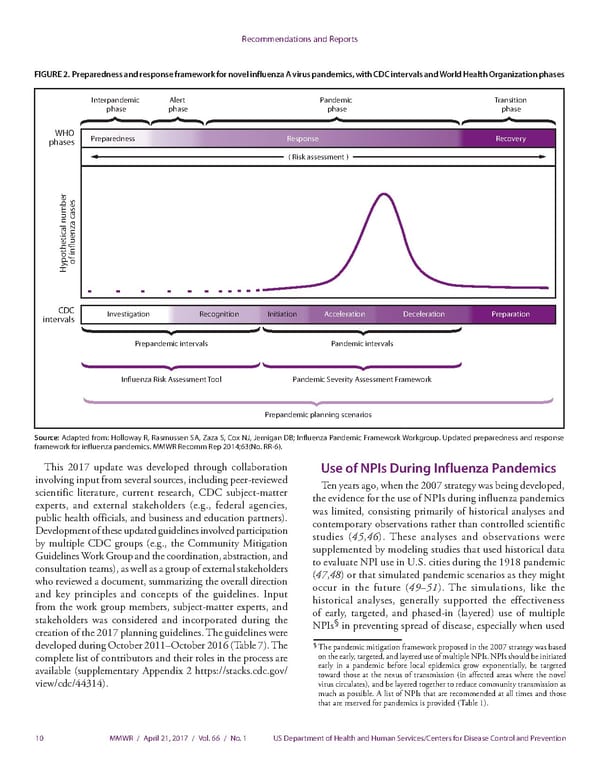Recommendations and Reports FIGURE 2. Preparedness and response framework for novel influenza A virus pandemics, with CDC intervals and World Health Organization phases Interpandemic Alert Pandemic Transition phase phase phase phase WHO Preparedness Response Recovery phases ( Risk assessment ) ypothetical number of influenza cases H CDC Investigation Recognition Initiation Acceleration Deceleration Preparation intervals Prepandemic intervals Pandemic intervals Influenza Risk Assessment Tool Pandemic Severity Assessment Framework Prepandemic planning scenarios Source: Adapted from: Holloway R, Rasmussen SA, Zaza S, Cox NJ, Jernigan DB; Influenza Pandemic Framework Workgroup. Updated preparedness and response framework for influenza pandemics. MMWR Recomm Rep 2014;63(No. RR-6). This 2017 update was developed through collaboration Use of NPIs During Influenza Pandemics involving input from several sources, including peer-reviewed Ten years ago, when the 2007 strategy was being developed, scientific literature, current research, CDC subject-matter the evidence for the use of NPIs during influenza pandemics experts, and external stakeholders (e.g., federal agencies, was limited, consisting primarily of historical analyses and public health officials, and business and education partners). contemporary observations rather than controlled scientific Development of these updated guidelines involved participation studies (45,46). These analyses and observations were by multiple CDC groups (e.g., the Community Mitigation supplemented by modeling studies that used historical data Guidelines Work Group and the coordination, abstraction, and to evaluate NPI use in U.S. cities during the 1918 pandemic consultation teams), as well as a group of external stakeholders (47,48) or that simulated pandemic scenarios as they might who reviewed a document, summarizing the overall direction occur in the future (49–51). The simulations, like the and key principles and concepts of the guidelines. Input historical analyses, generally supported the effectiveness from the work group members, subject-matter experts, and of early, targeted, and phased-in (layered) use of multiple stakeholders was considered and incorporated during the NPIs§ in preventing spread of disease, especially when used creation of the 2017 planning guidelines. The guidelines were developed during October 2011–October 2016 (Table 7). The § The pandemic mitigation framework proposed in the 2007 strategy was based complete list of contributors and their roles in the process are on the early, targeted, and layered use of multiple NPIs. NPIs should be initiated available (supplementary Appendix 2 https://stacks.cdc.gov/ early in a pandemic before local epidemics grow exponentially, be targeted toward those at the nexus of transmission (in affected areas where the novel view/cdc/44314). virus circulates), and be layered together to reduce community transmission as much as possible. A list of NPIs that are recommended at all times and those that are reserved for pandemics is provided (Table 1). 10 MMWR / April 21, 2017 / Vol. 66 / No. 1 US Department of Health and Human Services/Centers for Disease Control and Prevention
 Community Mitigation Guidelines to Prevent Pandemic Influenza Page 11 Page 13
Community Mitigation Guidelines to Prevent Pandemic Influenza Page 11 Page 13